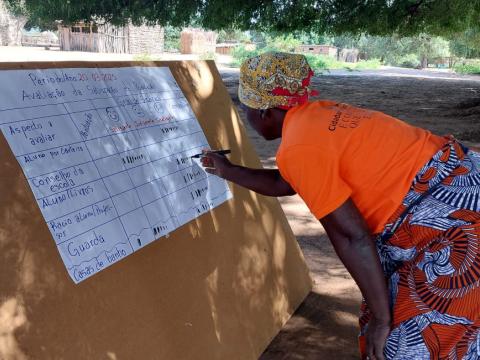From Unconscious Exclusion to Leading at the Decision-Making Table

There was a time when women had no seat at the decision-making table. Their role was limited to obeying without question, while men dominated discussions about the community’s future. If, in urban areas, where cultural norms are more fluid, women’s participation in decision-making remains a challenge, what can be said of rural communities? In places like Guijá and Mabalane districts, in Gaza Province, Mozambique, tradition has long placed women in a subordinate position to men.
For generations, gender inequalities were not even perceived by women as exclusion or a violation of their rights. Amélia Lhongo, a woman from Mabalane, recalls how these disparities were deeply ingrained in everyday life:
"We were raised to believe that we are different from men, that we don’t have the same abilities as they do. It was a matter of respect and upbringing. Anyone who questioned this would face consequences,” she explains. To her, a woman’s role was clear: to stay in the background and abide by the unwritten rules of a patriarchal society.
But things began to change, ten years ago, with the introduction of Citizenship, Voice, and Action (CVA), an approach implemented by World Vision in Guijá and Mabalane districts. This initiative fosters continuous engagement between communities and service providers ensure that all citizens, regardless of gender, have a voice in decisions that affect their lives.
Today, the transformation is undeniable, women and men now share the same space to discuss matters of community interest. Everyone has a say, men, women, the elderly, people with disabilities, and even children. Gender equality is no longer a distant aspiration but a lived reality. Alda Simango, an active participant in the CVA committees, shares her personal journey:
“With CVA, we realised that women also have good ideas and can contribute to the community's well-being. In the past, a woman wouldn’t even be allowed to sit on a chair, even if it was empty. We grew up hearing that chairs were only for men, and our place was on the floor. Now, with CVA, that mindset has changed. Everyone sits where they feel comfortable. I, for example, still prefer sitting on the floor, but now, it’s by choice, not obligation.”
This cultural shift runs deep. Today, most CVA committees are made up of women, many of whom hold leadership roles. Alda, who once sat on the floor because she had no other option, now leads discussions and helps shape decisions that influence the future of her community. She and many other women bring their wisdom and perspectives to solving the challenges their communities face.
“Women have always had this ability,” says Alda, “but we were never given the opportunity to show it.” Now, with the support of initiatives like CVA, their voices are not only heard but are instrumental in driving progress.
This is the portrait of a quiet revolution. Women who were once sidelined now take their rightful place at the decision-making table. They do not just participate, they lead, shaping the future with their resilience, strength, and vision. And above all, they do so on their own terms, whether sitting on a chair or on the floor, as Alda prefers, but always as a choice, never a limitation.